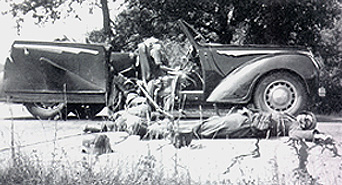On August 15, 1944 the men of the 517 Parachute Regimental Combat Team (PRCT) made their first combat jump into Southern France. They were the largest element of the First Airborne Task Force, with a little over 2,600 men. The 517's mission was to jump in an area outside Le Muy designated Drop Zone A. Their mission was capture the high ground near Le Muy, the towns of La Motte and Les Arcs, and block the main roads leading west to Toulon and Draguignan. The following interview was with Clark Archer as he describes their road block on the Les Arc-Trans road. Their surprise ambush led to the capture of a Mercedes convertible driven by several German officers and one enlisted man. Besides capturing the car, Archer and the men in his group also secured a black canvas brief case that revealed the German Army's unit redeployment to counter the Allied Invasion of Southern France. This intelligence coup had an impact on the course of the entire operation.
I arrived at the Chateau Ste. Roseline, the Regimental CP, at 11:00 am on D-Day, with Private Kellogg. We located PFC. Sutton and Stephan Wierzba and were instructed to set up a road block. We moved down the slope from the CP and located the Les-Arces-Trans Road. Kellogg and Weirzba were in a ditch with Sutton to their rear on the higher ground as a lookout and I took a position midway between them. At about 13:00, Sutton yelled, "One of ours. It's coming down Kellogg's side." Shortly thereafter, we could see the silhouette of a vehicle approaching. The car closed to within 50 yards of our position waving their arms as if to indicate a "friendly." There was considerable reluctance to commence firing, I did not see any visible weapons. All problems ceased as the convertible slowed down just past Kellogg's position and mine, they were Germans, there was no doubt about it. I stood up and started firing my grease gun into the driver's side door until it jammed, after firing eight or nine rounds. Then Kellogg popped up and fired a full clip from his M-1 rifle. Next, Wierba fired an "AT" grenade from his Springfield '03 rifle. The firing pin on the grenade had not been removed and subsequently did not detonate. It did, however, hit the driver's head, splitting his skull wide open. We cut the other Germans down with small arms fire. The Germans were carrying a black canvas brief case that contained maps. As I opened the case, I noticed that the top map was the German redeployment for the Invasion of Southern France. I put everything back in the case and rushed everything back to Headquarters. This intelligence latter proved helpful in countering the German redeployment of some of their forces as the invasion was unfolding. Later, I found out in a book titled "The Champaign Campaign" that an American OSS officer later tried to take credit for finding the brief case and plans even coming up with a story about capturing the car. Of course, that was all nonsense.
Not long after the battle, the car was put back into operational use by John "Boom Boom" Alicki, who kept it hidden for several days and later made several excursions with it.
It seems, at all of our 517th annual reunions, when the guys start talking about the war, that everybody in the unit seems to have a story on how they captured this car (laugh).
|
|
Copyright 1998 Patrick O'Donnell
_________________________________________________________________-
Entry of Oct 06, 2003 at 14:36 [EST]
Name: a mammone
Unit:
EMail: amammone@twcny.rr.com
How I found the 517th page: unknown
Comments: i am related to sgt. nick tinello who was an original 517th member. he and all members of the unit made sacrifices which we should all be grateful for and recognize. much media attention is given to the 101st due to hollywood. americans were fighting in the pacific from 12/7/41 on and we invaded north africa in nov 1942 with over 100,000 men, facts that are forgotten. my regards to the warriors.
|
